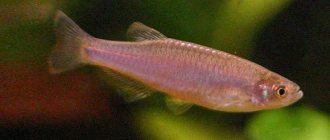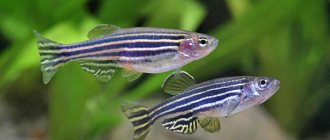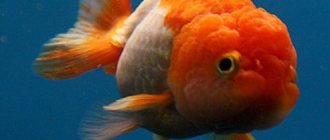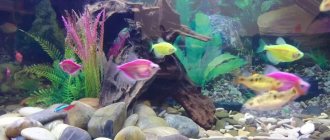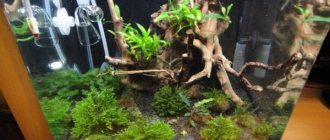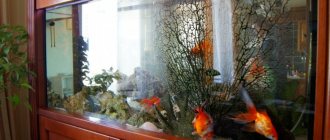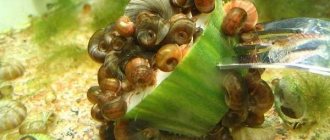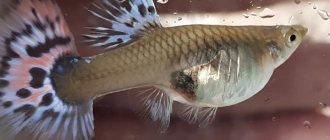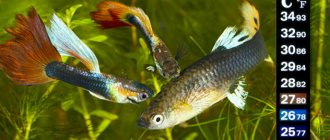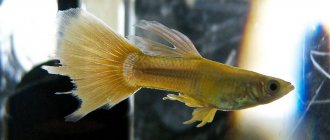Beautiful and bright, like precious stones, zebrafish were brought to Europe in 1911. They first appeared in Russia in 1958. The homeland of these fish is Southeast Asia: Thailand, Myanmar, Sunda Islands. The peculiarity of zebrafish is that their translucent body changes color. Sometimes the fish takes on a pink tint, sometimes bluish or olive. Along the entire length of the fish there is a clearly visible reddish stripe with a border. In young individuals it is more noticeable, in adults it disappears completely. The body of the fish is somewhat flattened on the sides. The dorsal and caudal fins are greenish-yellow. The anal fin is yellowish-spotted. If you look closely, aquarium zebrafish have small whiskers that point downward.
Description
These are small, playful fish, whose body length reaches 6 cm. They have an elongated, graceful body, painted in different shades. Wide stripes stand out on the body. The color depends on the type.
In nature, the size of zebrafish can reach 10-15 cm. Fish can be found in streams, canals, ponds, and rivers. Some adults can be found in puddles in rice fields after heavy rains. In nature, fish feed on plankton, insects and seeds.
Several dozen individuals of different colors and shapes have been bred for aquariums. There are genetically modified species of zebrafish with unusual colors.
Kinds:
- zebrafish pink;
- leopard zebrafish;
- pearl;
- point;
- fluorescent;
- kyatite;
- zebra;
- cherry;
- blue;
- rerio;
- glofish.
This is only a small part of the individuals that are most often found in pet stores.
Pink danios
Translucent fish whose color changes depending on the environment from bright pink to bluish. On the body, at a certain angle of light, stripes of a blue or violet hue are clearly visible. Fins are green or olive. Red gills.
Danio leopard
Translucent body with small dark spots, reminiscent of the color of a leopard's skin. The leopard danio was artificially bred.
Danio pearl
Pearl fish have uneven coloration. The body is translucent with a veil red or light green tint. Closer to the tail the color turns blue.
Spot zebrafish
A translucent body with small dots that shimmer blue when exposed to light. They grow up to 4.5 cm in length. Zebrafish fluorescent
Genetically modified aquarium fish zebrafish. When exposed to ultraviolet light, the body begins to glow green or white. Can be in different, bright neon colors. The color is dense. Length – up to 5 cm.
Danio kyatit
Orange-finned fish. The color is translucent. There may be orange stripes or spots on the body.
Danio zebra
This species received its name due to the similarity of color to the skin of a zebra. Dark stripes run along the entire light body. The stripes go from head to tail.
Danio cherry
These are translucent fish with transparent yellowish or reddish fins and red gills. Instead of stripes on the body, you can see rounded spots of a dark color.
Danio purple
These are genetically modified individuals of different purple shades: from lavender to plum. Thin translucent stripes can be seen along the body.
Blue zebrafish
These are deep blue fish with pinkish stripes from the tail to the gills. Stripes can be golden, pink, blue.
Zebrafish
The most popular fish bred at home. These are colorful individuals with dark stripes from tail to gills.
Danio firefly
Genetically modified species. Fish glow in the dark, which is why they got the name “firefly”. Unlike neon, their body is translucent, and the stripes stand out brightly with fluorescent light.
Why don't they reproduce?
Both beginners and experienced aquarists may encounter a common problem: zebrafish do not produce offspring despite all their efforts.
Main reasons:
- Genetic pathologies, injuries. Infertility can be primary or secondary: either the female never became pregnant at all, or over time she stopped spawning.
- Fungal or bacterial diseases.
- Immaturity of the reproductive system. The age of puberty in zebrafish is quite vague: one fish is ready to reproduce as early as 5 months, while another needs a couple more months to grow.
- Old age.
- Incorrect timing or lack of interest in the fish. The inhabitants of the aquarium are living creatures; they cannot mate on cue. It’s worth waiting a little or adding a few more individuals to the aquarium.
- Too cool or stagnant water. Increasing the temperature and changing water are prerequisites for the appearance of readiness for reproduction.
- Stress due to overcrowding. In cramped conditions, fish have a hard time, and the sexual instinct is replaced by anxiety.
- Poor nutrition. In order for the female’s body to prepare for pregnancy, it is necessary to give her live food.
- Fossil of eggs in the abdomen of a female.
There is one more nuance that is typical for beginners in aquarium keeping: same-sex fish can live in the same vessel. This is a clear reason that determines the impossibility of reproduction. It is easy to correct the situation: transfer some of the pets to another aquarium and add zebrafish of the same species, but of the opposite sex.
Aquarium preparation
The fish will be comfortable living in a spacious aquarium. This is a pack breed, so it is recommended to purchase 5-8 individuals at once. It is not advisable for fish to be alone or in groups of 2-3. Buy a spacious aquarium, at least 50 liters. A tank of 20-30 liters is not enough for them.
Before moving in, the aquarium needs to be prepared. A layer of soil is lined at the bottom and plants are planted. You can use clean medium sand or gravel as soil. Plants and decorations are a must for a comfortable stay. Plants should not be planted in the middle; it is better to place them along the edges to leave room for free floating. Fish love to hide, so place some hiding places, driftwood or a house on the bottom.
Tap water can be used, but it must first be settled. Comfortable water temperature is 22-26 degrees. There must be enough oxygen in the water, so purchase the necessary equipment: filter, pump, lamp, thermometer. Additionally, you will need a net, a scraper, and a pump for pumping water.
Care and maintenance
Experts recommend starting this breed for beginning aquarists, as these are unpretentious fish. They get along well with peaceful breeds, do not conflict with neighbors, and love to be in a pack. Aquarium zebrafish love current, so they often spin around the filter or in the water flow.
Before introducing fish, you must wait until the nitrogen cycle is established. You cannot place fish in an unprepared aquarium. They may get sick or die. Buy a thermometer to monitor the water temperature in your aquarium. At a constant temperature of 22-24 degrees, fish will live longer.
To reduce stress, introduce fish into the aquarium slowly. When stressed, males and females may lose color or turn pale. After purchasing, lower the danek in a store bag to the bottom of the aquarium. They will gradually get used to the new environment. If there is fish in the aquarium, new zebrafish should be kept in quarantine for 2 weeks to weed out sick or non-viable individuals.
Fish live in the upper layers of water, so buy floating, cotton food for them. Don't skimp on plants. Plants enrich the water with oxygen and clean the aquarium. Some plants serve as food.
It is necessary to change the water in the aquarium regularly. You can change no more than a quarter of the total volume at a time. Water replacement should be done once a week. Once a month it is necessary to completely rinse the aquarium, siphon the soil, and clean the filter.
Zebrafish require an aquarium with a lid as they love to jump. They may accidentally jump out of the aquarium and die. There should be an oxygen cushion of at least 5 cm between the lid and the water.
Fish need constant lighting, so be sure to install a lamp. Daylight hours should last no more than 12 hours, then the lights are turned off. With constant light, the fish will be lethargic, weak, motionless, and the color will fade.
Price
The cost range for aquarium zebrafish is quite wide: depending on the beauty of appearance and the complexity of delivery, the price is 30 rubles and an order of magnitude more. Well-known and affordable rerios are the cheapest, you can find them in any pet store. Genetically modified fluorescent fish cost a little more. But the rare “firefly” is difficult to get, and the price for it is steep.
When talking about aquarium fish, one cannot fail to mention zebrafish - small, nimble and cheerful. There are many types - from the miniature khopra to the 9-centimeter dangil. It’s hard to imagine a home aquarium without a flock of these cheerful, unpretentious inhabitants. If you liked the article, leave comments and share a link to it on social networks.
Nutrition
Danios are omnivores. You can buy any cotton fish food for them. But you can’t overfeed the fish. Overfed fish can quickly become ill. If the belly swells during feeding, the fish has overeaten. When you overeat, toxins accumulate in the body, which can cause death.
Excess food in water is a favorable environment for the development of bacteria and microbes. You need to feed the fish 1-2 times a day in small portions. Make sure the fish finish the food within 5 minutes. Residues should be carefully removed from the water. Fish can be given live, frozen, or dry food.
Animal feed:
- mosquito larvae;
- tubifex;
- crustacean plankton;
- coretra.
Recommended plant food:
- chopped lettuce;
- dandelion;
- spinach;
- egg yolk.
The food should float closer to the surface, since the fish spend most of their time in the upper layers of the water. Don't buy bulk fish food. The fish have a small mouth and a small stomach the size of an eyeball. The ideal food that can be bought in the store is chips.
Diseases
Zebrafish diseases are often provoked by dirty water, and they are also susceptible to fungal diseases. Pet obesity becomes a real scourge for the owner .
Obesity
Heavy feeding leads to overeating, and the zebrafish begin to gain weight. Balanced food and strict dosages will prevent fish obesity.
Bug-eyed
A dangerous disease that is difficult to recognize at the initial stage . It occurs when fish are preparing for spawning and is provoked by poor-quality water.
The female's abdomen enlarges, which many mistake for filling with eggs.
Several weeks pass, the bloating of the abdomen does not go away, and bulging of the eyes is added to it. At the last stage, the eyes fall out and the fish dies.
Alkalosis, or alkaline disease
The cause of alkalosis, or alkaline disease, is deviations in the acid-base parameters of water .
Rerio react to disturbance by jumping out of the water and scratching against the walls of the aquarium. The skin of the fish turns pale.
To restore normal behavior of pets, it is necessary to equip the aquarium with a pH buffer. When the acid-base balance is normalized, the disease will go away.
Trichodinosis
Careless cleaning of decorations and other objects in the aquarium leads to the spread of trichodina ciliates.
Fish infected with it turn pale, begin to itch against the walls, and a dirty coating appears on their body. Control methods: raise the water temperature to 30 °C and give the fish salt baths.
Tuberculosis (mycobacteriosis)
The disease is introduced into a home pond with poorly washed soil, algae and already infected individuals . Marked by lethargic behavior, loss of scales and refusal to eat.
At the early stage of the disease, fish are given Kanimicin, mixing the medicine with food in a 1:1 ratio. An advanced disease cannot be cured; the fish will inevitably die.
Bright and nimble schools of zebrafish create a positive picture of the underwater world.
Peaceful and easy to keep, they will help you master the basics of aquarium keeping and give you a lot of positive emotions.
Zebrafish breeding
Zebrafish reproduction does not require special conditions. These are viviparous fish that reproduce quickly. You need to take one female and two or three males. They need to be transplanted into a separate aquarium for spawning and wait. If the conditions for spawning in the aquarium are suitable, the female will lay eggs in the morning. The males will see the eggs and begin to actively fertilize them. Spawning lasts until the female completely lays eggs. When the female runs out of eggs, her belly will shrink. During one spawning, a livebearer can lay 200 eggs. After spawning, tired fish are moved back to the aquarium.
In order for fertilized eggs to be preserved, it is necessary to add antifungal agents to the water. In two days the caviar will be ripe. The eggs will hatch into larvae. They attach to any surface and remain motionless for about a week. After 6-7 days, the larvae hatch into zebrafish fry. They need to be fed ciliates. After 2-3 days, live dust is added to the diet, and after a week - cyclops and brine shrimp. As they grow, the diet expands.
Reviews
Sometimes cases arise when the female carries eggs, but does not want to spawn. Then you need to help her shed eggs that are overripe. I place the pregnant individual in a ball of wet cotton wool and hold it motionless with my left hand. I carefully squeeze out the overripe caviar with my right hand. If everything happened normally, then she will be ready for reproduction after seven days. Albina, Moscow
Pink danios willingly spawn both in general and in a separate tank. I always take several males for 1 female. Leopard danios spawn approximately once every four weeks, and remain faithful to each other throughout the mating season, and golden danios can remain paired all their lives, but I haven’t tested it myself! I don’t have any gold ones yet, but I’m planning to buy them. Denis, Voronezh
How to distinguish a female from a male
Males are smaller than females, and their bodies are more elongated. Females have a rounded belly. If the female has a swollen belly during the spawning period, she carries eggs. Males can be recognized by their bright colors. Some species have characteristic distinctive features:
- firefly or glofish: males have orange stripes, females have yellow stripes;
- spot zebrafish: males have a white abdomen, females have an orange one;
- Burmese: males have an orange stripe on the abdomen, females have a white stripe.
Compatibility with other fish
This is an ideal fish for the home aquarium, especially if there are different varieties in it. Danki are compatible with different fish; they are friendly, unpretentious fish.
Danios are bought and stocked in small flocks of 5 individuals. In smaller numbers they will feel lonely. Many novice aquarists are often concerned that fish are chasing each other. There is no need to worry, zebrafish are school animals, so they feel more comfortable this way.
For your neighborhood, choose the same peace-loving fish:
- thorns;
- minors;
- rasboras;
- neons;
- tetras.
It is not recommended to add aggressive and predatory fish. Avoid buying goldfish, angelfish, large catfish, eels, carp, barbs, and discus.
Consequences of incorrect placement
If the aquarist does not take into account the characteristics and requirements of various species, then the consequences for Danio can be very different:
- stress;
- lethargy;
- loss of appetite;
- various diseases caused by the previously listed factors;
- death due to illness or aggression from neighbors.
It is important to understand that peaceful schooling fish can also show aggression if the maintenance rules are violated. Perhaps the aquarium is overpopulated, or there are too few individuals in the school of Danios. In the first case, you need to increase the volume of the aquarium or add extra fish. In the second, add schooling fish so that there are at least 6 of them. After this, they will feel more confident, and other fish will stop harassing them.
Zebrafish diseases
If improperly cared for or maintained, zebrafish can become ill. The most common disease is dropsy. This disease occurs due to overfeeding, contaminated water, or improper maintenance. Symptoms of the disease: protruding scales, bulging eyes, swollen abdomen. With dropsy, treatment is useless, the fish die.
Some fish suffer from chronic diseases. Most often this is a curved spine. The spine bends due to stress. The disease can be recognized by protruding scales and gills. If the fish is not helped, it will die.
A characteristic disease is plystophorosis. This is an acquired disease that manifests itself as white spots on the body. Gradually the spots turn into ulcers. The fish looks shabby, swims at a 90 degree angle, and is exhausted. Such fish need to be isolated, the aquarium is cleaned, washed, and disinfected.
Unpretentious zebrafish are ideal fish for beginner aquarists, as well as for people who do not have a lot of time to care for their aquarium. They can be fed with store-bought chip food; there is no need to monitor the water temperature or maintain a nitrogenous environment. They easily adapt to different conditions, tolerate relocation well and are peaceful friends with any fish.
Role in science
Danio rerio visited space and lived on an orbital station.
They were also used as a model to study the peculiarities of embryo development and the function of vertebrate genes. Observation of development is greatly simplified by the fact that the processes occur outside the mother's body. Embryos are distinguished by their endurance, large size, transparent body and good health. These qualities make it possible to use fish for studying developmental biology.
Very often, zebrafish are used for phenotypic screening of medications. Before starting to use chemical compounds, the pharmacological activity of this substance is determined. In zebrafish, some body systems interact with chemicals in a similar way to humans. This is especially true for the cardiovascular system. When studying toxic substances and pharmacokinetics, reliable results are obtained. There is a possibility of developing lines of transgenic zebrafish that will specifically imitate human diseases.
Multi-colored zebrafish caramels will undoubtedly decorate your aquarium, and their cheerful disposition will lift your spirits!
These fish do not require care, and can be recommended even to novice aquarists. They look very nice. They eat almost everything, but you should not give the fish large food, otherwise they may choke. To ensure that zebrafish remain strong and healthy, you should carefully monitor the microclimate in the pond. To do this, it is enough to monitor the temperature, remove leftover food, maintain cleanliness and regularly add settled water.
